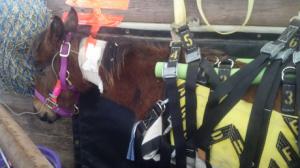By Nancy Brannon
In the early morning on March 18, 2014, eighteen starving horses and one mule were rescued from Anthony Richardson’s property on Francis Road near Whiteville, TN. Members of the American Humane Association Red Star team, along with Fayette County Animal Control, sheriff’s deputies, and veterinarian Dr. Jennifer Dunlap, were deployed to the farm to transport the animals to a temporary shelter where they could get immediate care. The Red Star team members said the animals were “literally starving to death.” Fifteen horses were in critical condition, with body scores of only 1 out of a possible 9. Five other horses were reported to have died.
Transporting such emaciated horses is not an easy task. The logistics were carefully organized by Josh Cary with the American Humane Association Red Star team, who lined up the horse trailers and led the round-up of horses. “We had to slowly and gently move all the horses into one area,” Dr. Dunlap explained. “If they spook, they could pass out because they are so weak. First, we gently caught those who were easy to catch. Then, we used a small bit of food to catch the next easiest to catch. For those who were not halter broken, we gently herded them into an area we had created so they could walk into the trailer. We had a variety of trailers to accommodate all the sizes of horses. It’s a very careful, slow, deliberate process. But having skilled personnel working smoothly together allowed us to clear the property with two to two and a half hours, as we moved the horses to the shelter site.”
The 19 animals are a “mixture,” said Dunlap, “from weanlings to 18-year-olds; miniatures, paints, saddle horses, Tennessee Walking horses and Quarter Horses. It’s SAD!” she emphasized.
Veterinary care began immediately as the horses reached their new, temporary home. “Four horses were so anemic due to starvation that they had to have blood transfusions,” reported Dr. Dunlap. First these horses had oxygen therapy, using puppy health oxygen masks, courtesy of the Shelby County Fire Department. The blood transfusions bumped up their red cell count so they could be removed from the oxygen therapy. “The oxygen therapy and blood transfusions allowed their bone marrow to start producing more red blood cells, now that they are on a better nutritional plane,” Dunlap explained.
Three days prior to the rescue, Dr. Dunlap, with the owner’s permission, had a round bale of hay delivered to the farm so the horses could stay alive until the rescue could take place. When rescuers moved in, two horses were too weak to stand and had to be placed in Anderson slings. Several had IV fluids. But just a week later, the horses showed improvement and were able to come off the IV fluids.
On the Dunlap Equine Services facebook page, Dr. Dunlap posted photos of the equine “blood donor heroes.” She wrote: “One by one they came – Horse Hero Donors to provide life saving blood. They stood still as units of blood were obtained, as if they knew how important their task was. Our first donor horse, Torque, provided blood for little Andy” which soon made a huge “difference in Andy's whole demeanor. Sunny helped a little filly on oxygen and she has [since] been able to come off her oxygen. Blue…donated enough to help a mini and another horse.” Dunlap expressed her thanks to these great horses and their owners for donating much-needed blood.
Kim Winstead at The Stockyard Nursery and Feed said that Purina (through her store) had donated several bags of Equine Senior feed, hydration hay, and other nutritional supplements to help the horses.
Now comes the critical task: getting them back on feed slowly. “Their GI (gastro-intestinal) tracts have shrunk,” Dunlap explained, “so the Red Star team members were feeding them small meals every two hours for the first three to five days. We had to watch for organ shut down. We still continually worry about their GI tracts functioning normally; we worry about colic and about choke. They’ve been without food for so long that some horses want to bolt their food. We’re using Pre-Vent feeders to prevent choke.”
The week following their rescue, the horses were starting to perk up and show some personality. “It’s VERY rewarding!” Dunlap exclaimed. That’s a far cry, literally, from the week before, when Dunlap shed tears in the courtroom on March 19, explaining their situation and showing photos of the starving horses to Judge Mike Whitaker. At that hearing, Anthony Richardson was charged with 18 counts of Animal Cruelty and his bond was set at $90,000 - $5,000 per horse. Richardson’s attorney is Terry Dycus of Somerville, TN. Richardson’s second scheduled court date was March 24 in Fayette County court.
Feeding starving horses that are on the verge of death is a difficult process, which Dr. Dunlap explained: “We started them with one handful of alfalfa hay and ¼ pound of Senior feed, rotating every two hours. We gave them 15 minutes with a salt block twice a day. They were so desperate for salt that we had to control their intake.” A week and a half later: “Now they have free choice mixed grass hay, and we’re rotating every four hours with a half flake of alfalfa and ½ pound of Senior feed. They still get 15 minutes twice a day with their salt block. Otherwise, they gorge it. It’s really an art to bring a horse back from starvation,” Dunlap said.
Dr. Dunlap had much praise for the American Humane Association Red Star team. “They are very well trained and skilled in seizure, forensics, and the technology of large animal rescue.” I asked about forensics and if the deceased horses would have an autopsy. Dunlap said that samples of bone will be taken for long bone fat analysis and sent to the University of Minnesota veterinary lab. “On the deceased horses, they take a femur and split it. Fat is leached from bone marrow last, so analysis of long bone for fat [or lack thereof] can be a strong indicator of starvation.”
The horses will continue to receive care as the legal case proceeds in Fayette County court. As soon as they are able, the horses will be transported from their temporary shelter to a long-term care facility to complete their rehabilitation. After the legal case is settled, the horses could possibly be up for adoption.
Read more and see video coverage of the rescue at these news sources:
WREG News Channel 3 video: http://wreg.com/2014/03/18/18-starving-horses-rescued-after-five-die/
http://wreg.com/2014/03/19/bond-set-for-man-charged-with-18-counts-of-animal-abuse/
Channel 24, Local Memphis.com video: http://www.localmemphis.com/story/d/story/man-arrested-after-rescue-team-seizes-18-starving/23508/yMV_AWA5xkmpWbTjDTyzsA
WMC TV coverage: http://www.wmctv.com/story/25010031/15-starving-to-death-horses-rescued-5-found-dead-in-raid
Memphis Commercial Appeal: http://www.commercialappeal.com/news/2014/mar/18/horses-found-dead-or-starving-in-fayette-county/
The American Humane Association blog: http://americanhumaneblog.org/2014/03/red-star-deploys-save-starving-horses-tennessee/
In the early morning on March 18, 2014, eighteen starving horses and one mule were rescued from Anthony Richardson’s property on Francis Road near Whiteville, TN. Members of the American Humane Association Red Star team, along with Fayette County Animal Control, sheriff’s deputies, and veterinarian Dr. Jennifer Dunlap, were deployed to the farm to transport the animals to a temporary shelter where they could get immediate care. The Red Star team members said the animals were “literally starving to death.” Fifteen horses were in critical condition, with body scores of only 1 out of a possible 9. Five other horses were reported to have died.
Transporting such emaciated horses is not an easy task. The logistics were carefully organized by Josh Cary with the American Humane Association Red Star team, who lined up the horse trailers and led the round-up of horses. “We had to slowly and gently move all the horses into one area,” Dr. Dunlap explained. “If they spook, they could pass out because they are so weak. First, we gently caught those who were easy to catch. Then, we used a small bit of food to catch the next easiest to catch. For those who were not halter broken, we gently herded them into an area we had created so they could walk into the trailer. We had a variety of trailers to accommodate all the sizes of horses. It’s a very careful, slow, deliberate process. But having skilled personnel working smoothly together allowed us to clear the property with two to two and a half hours, as we moved the horses to the shelter site.”
The 19 animals are a “mixture,” said Dunlap, “from weanlings to 18-year-olds; miniatures, paints, saddle horses, Tennessee Walking horses and Quarter Horses. It’s SAD!” she emphasized.
Veterinary care began immediately as the horses reached their new, temporary home. “Four horses were so anemic due to starvation that they had to have blood transfusions,” reported Dr. Dunlap. First these horses had oxygen therapy, using puppy health oxygen masks, courtesy of the Shelby County Fire Department. The blood transfusions bumped up their red cell count so they could be removed from the oxygen therapy. “The oxygen therapy and blood transfusions allowed their bone marrow to start producing more red blood cells, now that they are on a better nutritional plane,” Dunlap explained.
Three days prior to the rescue, Dr. Dunlap, with the owner’s permission, had a round bale of hay delivered to the farm so the horses could stay alive until the rescue could take place. When rescuers moved in, two horses were too weak to stand and had to be placed in Anderson slings. Several had IV fluids. But just a week later, the horses showed improvement and were able to come off the IV fluids.
On the Dunlap Equine Services facebook page, Dr. Dunlap posted photos of the equine “blood donor heroes.” She wrote: “One by one they came – Horse Hero Donors to provide life saving blood. They stood still as units of blood were obtained, as if they knew how important their task was. Our first donor horse, Torque, provided blood for little Andy” which soon made a huge “difference in Andy's whole demeanor. Sunny helped a little filly on oxygen and she has [since] been able to come off her oxygen. Blue…donated enough to help a mini and another horse.” Dunlap expressed her thanks to these great horses and their owners for donating much-needed blood.
Kim Winstead at The Stockyard Nursery and Feed said that Purina (through her store) had donated several bags of Equine Senior feed, hydration hay, and other nutritional supplements to help the horses.
Now comes the critical task: getting them back on feed slowly. “Their GI (gastro-intestinal) tracts have shrunk,” Dunlap explained, “so the Red Star team members were feeding them small meals every two hours for the first three to five days. We had to watch for organ shut down. We still continually worry about their GI tracts functioning normally; we worry about colic and about choke. They’ve been without food for so long that some horses want to bolt their food. We’re using Pre-Vent feeders to prevent choke.”
The week following their rescue, the horses were starting to perk up and show some personality. “It’s VERY rewarding!” Dunlap exclaimed. That’s a far cry, literally, from the week before, when Dunlap shed tears in the courtroom on March 19, explaining their situation and showing photos of the starving horses to Judge Mike Whitaker. At that hearing, Anthony Richardson was charged with 18 counts of Animal Cruelty and his bond was set at $90,000 - $5,000 per horse. Richardson’s attorney is Terry Dycus of Somerville, TN. Richardson’s second scheduled court date was March 24 in Fayette County court.
Feeding starving horses that are on the verge of death is a difficult process, which Dr. Dunlap explained: “We started them with one handful of alfalfa hay and ¼ pound of Senior feed, rotating every two hours. We gave them 15 minutes with a salt block twice a day. They were so desperate for salt that we had to control their intake.” A week and a half later: “Now they have free choice mixed grass hay, and we’re rotating every four hours with a half flake of alfalfa and ½ pound of Senior feed. They still get 15 minutes twice a day with their salt block. Otherwise, they gorge it. It’s really an art to bring a horse back from starvation,” Dunlap said.
Dr. Dunlap had much praise for the American Humane Association Red Star team. “They are very well trained and skilled in seizure, forensics, and the technology of large animal rescue.” I asked about forensics and if the deceased horses would have an autopsy. Dunlap said that samples of bone will be taken for long bone fat analysis and sent to the University of Minnesota veterinary lab. “On the deceased horses, they take a femur and split it. Fat is leached from bone marrow last, so analysis of long bone for fat [or lack thereof] can be a strong indicator of starvation.”
The horses will continue to receive care as the legal case proceeds in Fayette County court. As soon as they are able, the horses will be transported from their temporary shelter to a long-term care facility to complete their rehabilitation. After the legal case is settled, the horses could possibly be up for adoption.
Read more and see video coverage of the rescue at these news sources:
WREG News Channel 3 video: http://wreg.com/2014/03/18/18-starving-horses-rescued-after-five-die/
http://wreg.com/2014/03/19/bond-set-for-man-charged-with-18-counts-of-animal-abuse/
Channel 24, Local Memphis.com video: http://www.localmemphis.com/story/d/story/man-arrested-after-rescue-team-seizes-18-starving/23508/yMV_AWA5xkmpWbTjDTyzsA
WMC TV coverage: http://www.wmctv.com/story/25010031/15-starving-to-death-horses-rescued-5-found-dead-in-raid
Memphis Commercial Appeal: http://www.commercialappeal.com/news/2014/mar/18/horses-found-dead-or-starving-in-fayette-county/
The American Humane Association blog: http://americanhumaneblog.org/2014/03/red-star-deploys-save-starving-horses-tennessee/









